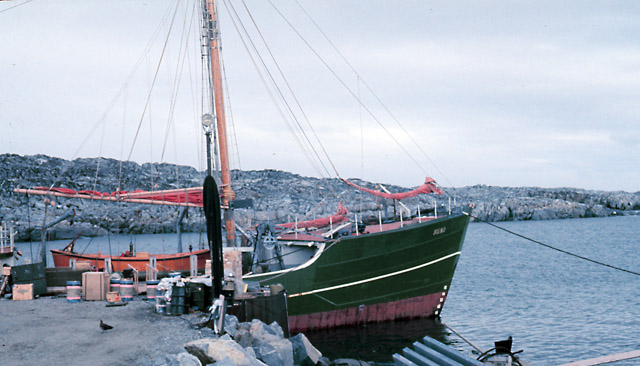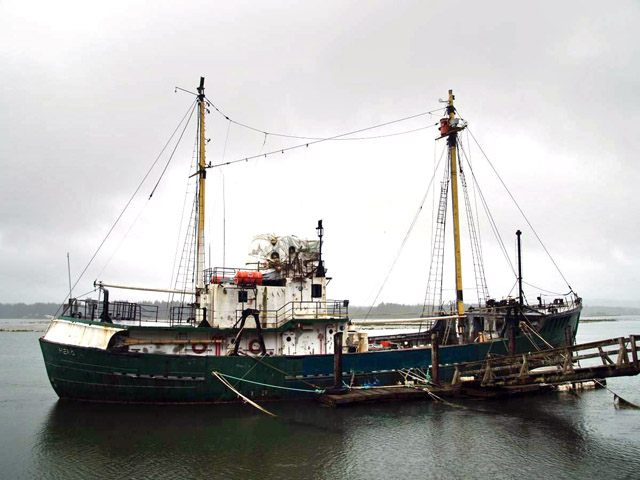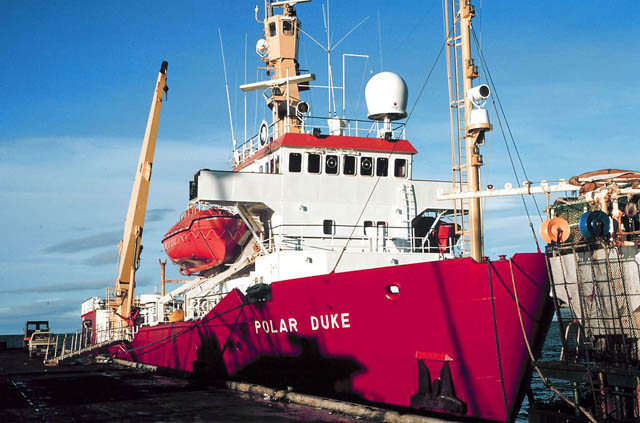Page 2/2 - Posted April 20, 2015
Lenie commanded respect during his tenure as captain of the Hero and beyondLangdon Quetin and Robin Ross studied the ecology and physiology of Antarctic krill for nearly 30 years and helped initiate the Palmer LTER, along with Fraser and others, in 1990. But as young scientists in 1981, they knew from colleagues that they would have to earn the captain’s respect. “Over time, we became good working partners and fast friends, sharing music, soccer games, and whale sightings [Pete, named after the captain, and Matilda], and especially our love of the ‘krill hunt,’” they wrote in an email. “We think it was our work ethic and our fascination with the ecosystem that won him over.” Lenie was famously well-versed in the local fauna, so it especially pleased Quetin and Ross the day that they taught him something new about krill. Through experimentation they found that differences in krill coloration – nearly transparent at the surface and deeply red at depth – was due to the fact that chromatophores (pigment-containing and light-reflecting cells) were contracted when the krill were in bright light, such as at the surface, and expanded when krill were in the dark at depth. “He was fascinated, and loved to watch the krill swimming around in the large tanks at Palmer Station,” they wrote. “That was a banner day.” Gaining Lenie’s approval seemed important to those who surrounded him. Tom Williams had heard many tales of his legendary future father-in-law before he first met Lenie when he married Alida Williams. The stories had built a super-sized image of Lenie – a man who had escaped Europe just before the war, who sailed around the world, who carried a pistol in his boot. “I was afraid of him,” Tom Williams admits. Then he finally met Lenie for the wedding. “This giant of a man was maybe five-foot-four and 120 pounds fully dressed, including his gun. “That scared me even more,” he adds. “He commanded respect. You knew he wasn’t bluffing. … Once he accepted you, he was always there for you. … He was dedicated to the scientists and he was dedicated to the crew, and he struck up a friendship with many of them.” The captain certainly wouldn’t suffer fools, however, and his feud with fellow mariner Jacque Cousteau took on a life of its own after the two crossed paths in 1972. Lenie and the Hero had been called upon to support the Frenchman and his ship Calypso during filming in Antarctica for the TV series The Undersea World of Jacques Cousteau. Tragedy struck when Calypso’s helicopter landed badly on a slope, and because of its angle to the ground, a tail rotor blade struck Calypso’s first mate and paleontologist Michel Laval on Deception Island. Lenie had reportedly warned Cousteau about the unpredictable winds and urged him not to launch the helicopter. As the story goes, Laval was brought aboard ship and Cousteau summoned Lenie over to look at him and determine his injuries. “Injured?” Lenie famously remarked after a brief examination, “Hell, this man is dead!” Neither Lenie nor the Hero was featured in the TV series. Recognition of the captain for his dedication to the program and the Antarctic would come in other ways. Lenie Passage between the Gossler Islands and the Joubin Islands in the Palmer Archipelago was named after the captain, who had originally suggested the passage be called after his beloved ship. Lenie is believed to be first to navigate and carry out soundings of the passage in Hero during January and February 1973. In addition, the unofficial name of the field camp used by NOAA researchers at Copacabana Beach on King George Island is the Captain Pieter J. Lenie Base, a little more than a mile from the Polish research station Arctowski. The Polish research station itself would also figure into the legend of Capt. Lenie. Arctowski was dangerously low on supplies one year to the point that the captain sailed to Palmer Station to load up with enough goods to get the Polish base through to its next resupply run. “From then on, the Hero and Capt. Lenie could do no wrong in the eyes of the Polish folks there, and a visit by the Hero was always a time for celebration,” Quetin and Ross wrote. “Things were different in that era. Capt. Lenie was in charge of everything – diplomacy with other stations and ships of different nationalities, hiring crew for the ship. Another mission of mercy involved rescuing the crew at Argentina’s Almirante Brown research station, which burned down in April 1984 after the base leader allegedly set a fire to avoid staying the winter in Antarctica. “We were the last ship in the area, and if we hadn’t been around, they may have been weeks waiting for one of their ships,” Owen says. “Lenie never hesitated, though we left Palmer Station after dark on a snowy night to get there.” Discipline and protocol never lacked when Lenie was at the helm. “With such a small ship, we basically lived in very close proximity to each other,” Quetin and Ross wrote. “Capt. Lenie ran it more like a family, with himself as the benevolent patriarch. He showed about one movie a week in the mess – and was firm about the tablecloth on the table, no hats on anyone sitting down to eat, and good manners.” Owen certainly recalls the rules about hats at the mess table after sitting down for the first time with captain. “I was coming off the deck and was cold, and said as much,” Owen says. “He gave me his signature onceover look – we, his crew, called it ‘stink-eye’ – as he considered my comment. [He] then suggested I might want to explore another line of work!” The decommissioning of the Hero – which, today, sadly sits beached in Bay Center, Washington, in disrepair – was the end of an era in many ways. Its successor was the research vessel Polar Duke, a 219-foot, ice-strengthened ship. Owen accompanied the Hero on its last voyage before it was decommissioned in 1984, and then joined the crew of the more modern Polar Duke, first as a marine technician and later as the marine project coordinator. The Hero was already an anachronism before she was retired compared to the emerging fleet of research vessels. “She was minimal in many ways. Just the way [Lenie] liked it,” Owen recalls. “His was the face of the USAP [then USARP] in the Antarctic Peninsula. … He was a sad man when the Hero was retired.” Lenie’s association with the Antarctic, however, didn’t entirely end in 1984. He worked later as an ice pilot on the Greek tourist ship Illiria. In a 1992 interview with Ron Naveen, president of Oceanites Inc., a nonprofit science and educational organization, Lenie explained why he continued to return to Antarctica in later years. “It’s clean. A fantastic place to travel. And I’m always hoping to find something new. The Hero, of course, was the last of the pure exploration ships. That is, people would get on her and say, ‘Go and see what you can find.’ The only reason I stayed was that no day was the same as the one before. Always something different. “And if there wasn’t any work to finish, we’d just go exploring. Those scientists were great. They always wanted to see what was around the next corner. Up until the last season in 1984, we still found a new place – new rocks, new depths. You get to meet a lot of different people that way.” Certainly, no one ever forgot meeting Capt. Pete Lenie. The Antarctic Journal and www.southpolestation.com |



For USAP Participants |
For The Public |
For Researchers and EducatorsContact UsU.S. National Science FoundationOffice of Polar Programs Geosciences Directorate 2415 Eisenhower Avenue, Suite W7100 Alexandria, VA 22314 Sign up for the NSF Office of Polar Programs newsletter and events. Feedback Form |





